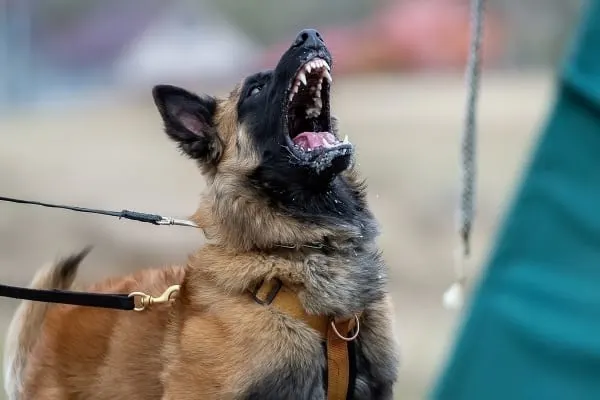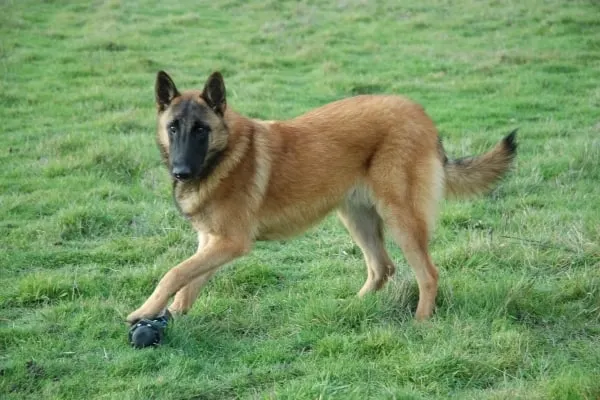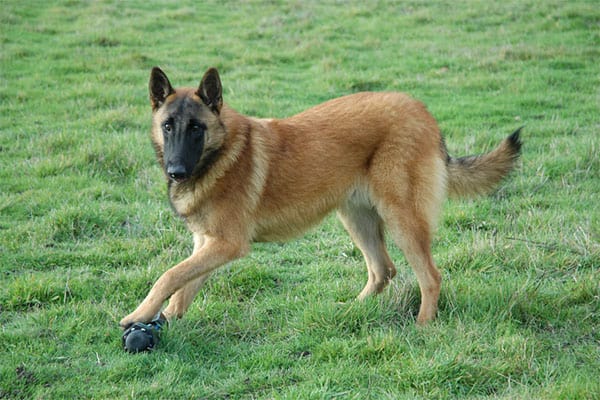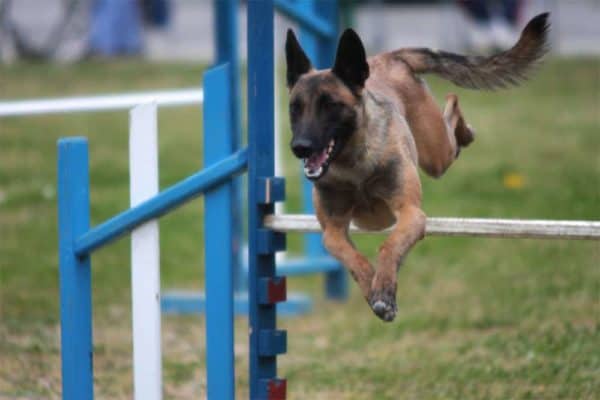Do Belgian Malinois Bark a Lot: How to Curb Excessive Malinois Barking
The Belgian Malinois dog breed is a working K-9 breed, pure and simple.
People who choose the Belgian Malinois dog breed purely to have a pet dog are often in for a big surprise when their adorable fluffy puppy starts to grow up and act out.
The Belgian Malinois may not be the biggest companion canine on the block, but they have no trouble being the loudest.
A Belgian Malinois that barks excessively may not actually be barking excessively. They may just be barking at a normal level for the Malinois breed.
But as we will discuss in this article, there are ways to train a Belgian Malinois to know when it is appropriate to use their bark to communicate.

Do Belgian Malinois Bark a Lot?
The Belgian Malinois is often mistaken for another shepherd dog – the German Shepherd.
Like German Shepherds, Belgian Malinois is considered a very vocal dog breed. In other words, they bark a LOT.
Belgian Malinois and other shepherd dog breeds are working dog breeds. They use their bark to communicate with their charges and their owners.
Many shepherd-type dog owners are unprepared for so much barking. This is the type of breed fact it is helpful to know before making a lifetime commitment to a Belgian Malinois dog.
Watch a Professional K-9 Trainer Work With Malinois Problem Behaviors
In this moving personal story on YouTube, you can learn from a Belgian Malinois owner how arranging for professional K-9 dog training helped her Malinois settle down and adjust to life in a community setting.
Perhaps even more importantly, the owner explains how she learned to be her dog’s trainer as well as a refuge in times of stress or anxiety.
This is an important video to watch because it highlights how problem behaviors in a Belgian Malinois can become dangerous enough to involve Animal Control.
As the owner in this video explains, the right training can literally make the difference between forcible relinquishment and being able to keep your dog.
Understanding Why the Belgian Malinois Dog Barks So Much
As the American Belgian Malinois Club (ABMC) highlights, the Belgian Malinois is a high-energy, active, and intelligent breed of dog.
These dogs have a unique breed of lineage and history. The Malinois was never intended to be a pure “pet” or companion canine to people. Rather, the Malinois breed was developed to work.
And Belgian Malinois were bred to do a very specific kind of work. At first, the Belgian Malinois was put to work herding and guarding livestock.
As the American Kennel Club (AKC) recounts, Belgian Malinois was primarily in charge of herding and guarding sheep and cattle.
These medium-sized dogs couldn’t necessarily throw their weight around herding animals twice or three times their size. But they could certainly assert their authority through their bark.
Over time, as herding and livestock dogs were less in demand, the Belgian Malinois found new work – this time in the military, police, and private sector.
The same instincts and traits that made Malinois so good at herding and guarding animals turned out to be useful in protecting and guarding people as well.
Today, the Belgian Malinois is one of the most sought-after dog breeds in the world for military and private K-9 protection, guarding, and security work.
When Malinois are trained to do these high-risk jobs, they use their bark to communicate with their handlers. So you could even say that the Belgian Malinois has been bred and trained for generations to bark.
This means that training a Belgian Malinois not to bark can start out looking like a tall order.
And as this article about a Malinois that barked to alert his family about a home fire illustrates, you don’t want to silence your Malinois. You just want to teach your dog how to use their bark appropriately.

Constant Barking Is One Reason Belgian Malinois Get Relinquished
The Belgian Malinois definitely isn’t the right breed of dog for every individual or family.
As the American Belgian Malinois Club (ABMR) points out, boredom is one very common reason why a Malinois might resort to barking nonstop.
There are many dog breeds that are perfectly happy with one or two short walks and a little playtime each day, but as VetStreet points out, the Malinois is not one of them.
These dogs have been bred for generations to work long, hard hours every day in often dangerous and difficult conditions.
They are true canine athletes who have high energy levels and an instinctive drive to run, jump, chase, and exercise.
A bored Malinois is not only going to be a barking Malinois but will likely also become a destructive and potentially aggressive Malinois as well.
Many dog lovers fall in love with an adorable Belgian Malinois puppy and make the decision to add one of these dogs to their family without knowing anything about the history of the breed.
When the Belgian Malinois reaches canine puberty, this is when the more aggressive behaviors start to show up. Not only is the dog bigger and stronger, but the barking is louder and longer.
For many owners, this is the first moment they realize their mistake and often the dog ends up at a rescue shelter as a result.
As the American Kennel Club (AKC) sadly reports, Belgian Malinois relinquishments have been on a steady incline for the last decade.

When to Start Training Your Belgian Malinois Not to Bark
The very first day you bring your Malinois puppy or rescue dog home is the right day to start training and socializing your dog.
Whether you plan to train your Belgian Malinois in a working dog role or you simply want your Malinois to be your pet, your dog will need a lot of help from you learning to do well in both roles.
Because the Belgian Malinois is a very smart dog that learns quickly, you want to keep training sessions short and very interesting.
Instead of one or two long training sessions, aim to do several shorter training sessions each day.
Add new lessons frequently to keep your dog interested and engaged. Only use positive reinforcement (treats, praise, pats, playtime), or your Malinois may become resistant or aggressive.
The Difference Between Training and Socialization
Even people who don’t own dogs usually have a general concept of what “dog training” entails.
You want your Malinois to learn common commands such as “sit,” “come,” “stay,” “fetch,” “leave it,” “go potty” and others so you can control your dog around other people and animals and have a well-behaved family pet.
But when it comes to canine socialization, the meaning is often less clear.
Socialization is what teaches your Malinois how to tell the difference between a friend or a neutral situation and a potential or real threat.
For example, let’s say you like to entertain in your home or your kids have friends over frequently.
The Belgian Malinois is a very protective, territorial dog breed that has a tendency to get jealous of strangers (animals and people).
Barking is one of many ways your dog may let you know they don’t want other people around. But you can’t just give up your life to keep your dog from barking or behaving aggressively.
Socialization is the part of the training that teaches your dog how to cope with having guests or visitors over to your home.
This needs to start early for any dog, but especially for a guarding dog breed like the Belgian Malinois.
Otherwise, once guests realize they will have to deal with your Malinois barking like crazy every time they visit, you may soon find you have no more willing visitors!

How to Choose a Pet Belgian Malinois Dog
It is important to know before you even start your search for a Malinois that these dogs are vocal.
Like most other shepherds (herding and guarding) livestock dog breeds, the Belgian Malinois is going to be vocal from day one. Barking is a desirable trait for the work these dogs are bred to do.
However, there is a difference between normal vocalizations that are associated with the Belgian Malinois breed and canine aggression that manifests as excessive barking.
Just like some people are more aggressive than others, some dogs can be more naturally aggressive than others.
Since the Belgian Malinois is already a challenging breed to keep as a pet, you definitely want to pick a dog with the most family-friendly temperament.
The best way to do this is to choose the breeder you work with carefully. You want to be able to meet your puppy’s parents and observe their temperament and behavior.
Aloof behavior around strangers is normal for well-bred, well-trained, and socialized adult Malinois. Aggressive behavior is not normal.
Choosing a well-bred Belgian Malinois puppy will get your new life together started on the right foot.




















